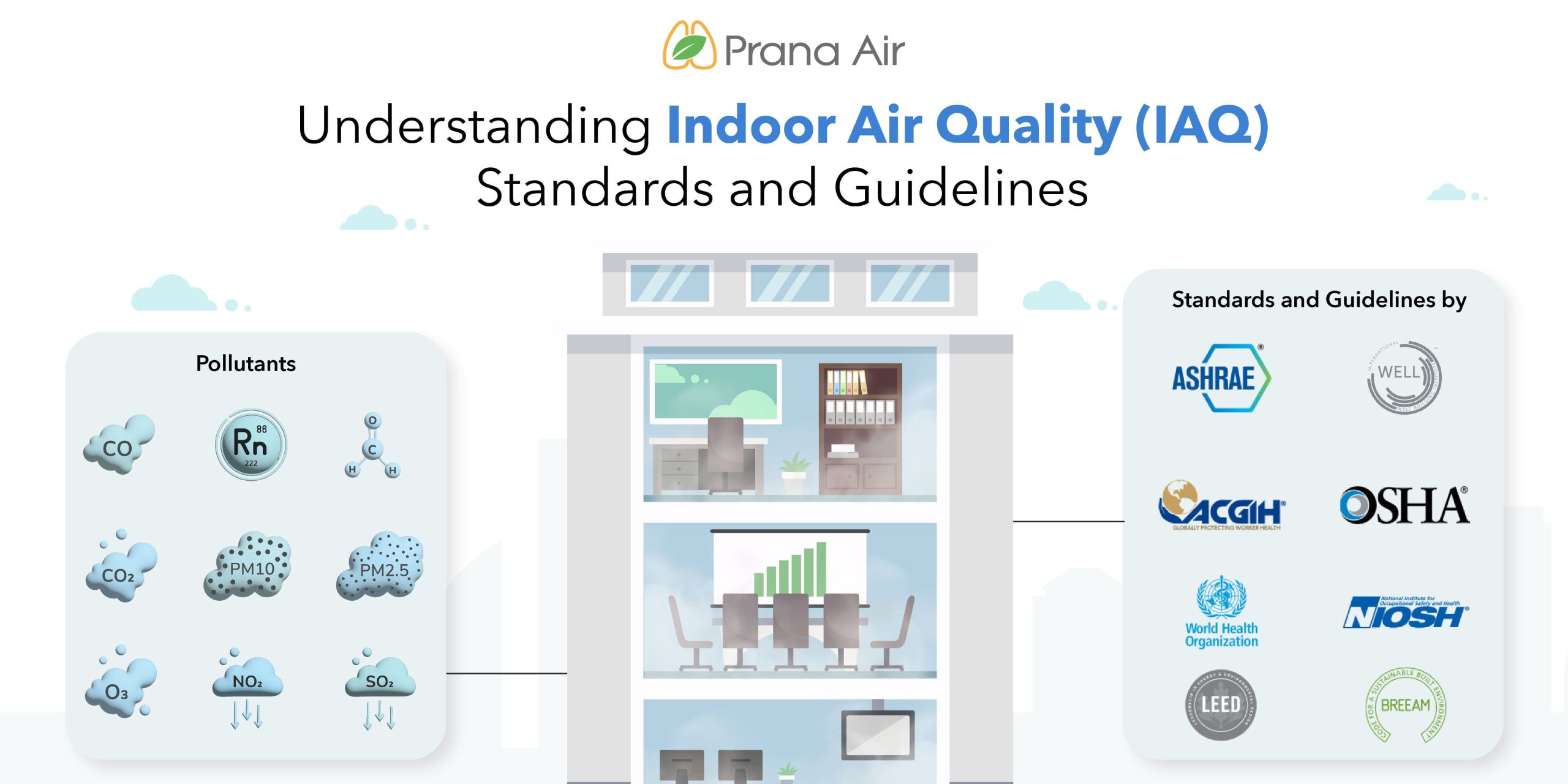Indoor Air Quality (IAQ) is necessary to maintain better health and comfort. Furthermore, Indoor air quality refers to the air in the house or any building space. Hence, Poor indoor air quality is a major concern that causes numerous health issues. As a result, Individuals can face respiratory concerns, allergies, and other problems. Therefore to address this concern, numerous IAQ standards and guidelines have been established.
Nevertheless, these promote better indoor air quality. Many organizations have marked the guidelines to ensure several points for buildings. Since, it includes their designs, constructions, and maintenance. These concerns on ventilation, air filtration, and pollutant control.
In this comprehensive guide, you can learn about the standards and guidelines of various organizations and agencies. Markedly, they have marked some parameters that affect the air quality. Let us know more in detail about these parameters and guidelines. Moreover, Prana Air’s Air quality monitors meet all the standards set by different organizations and agencies.
What are the pollutants affecting the indoor air quality?
Indoor air quality is a major concern because individuals spend more than 90% of their time. Thus, its effects can range from mild issues like irritation to extreme problems such as kidney failure or cancer. Hence, strict guidelines and standards are crucial to set. Because No level of some pollutants is exposure-able. These parameters check in the IAQ Standards and Guidelines.
Here are some common VOCs or air pollutants:
PM 2.5:
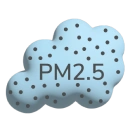
PM2.5 are fine particles with a 2.5 micrometer diameter. Besides, it is the most dangerous pollutant because of its size since it can easily go into the lungs and bloodstream. Moreover, numerous indoor activities are the sources of PM2.5 emissions. As it can be released from various indoor activities including cooking, dust, and others.
PM10:

PM10 is the particulate matter with 10 micrometers diameter. However, it has a diameter that is stuck in the nose or throat. Hence, it leads to several allergies and health issues. An individual with PM10 exposure can face cough, runny nose, eye stings, and other concerns.
CO2:

Carbon Dioxide is a natural and crucial gas in the environment. Since it acts as a greenhouse gas in the atmosphere. However, the main source of CO2 levels is indoor space confinement. Hence, poor ventilation increases the CO2 level in the indoor spaces. And it can cause various health issues. Especially, high CO2 level impacts the individual’s performance in any activity.
CO:

Carbon Monoxide is the most dangerous gas in indoor environments. Since, it is a colorless, odorless, and lethal gas. Furthermore, it is released from parking lots in buildings and basement lots. In effect, CO exposure is highly risky because it binds into the blood and affects the blood’s ability to carry oxygen.
NO2:

Nitrogen Dioxide is a pollutant that has various health effects. Because It emits from many sources such as poorly maintained home appliances. Including, stoves, ovens, water heaters, etc releases NO2 in the indoor air. In effect, Long-term NO2 exposure can lead to various health issues.
Radon:
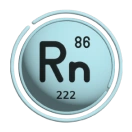
Radon gas is a radioactive noble gas. It is without any colour or odour and forms from decaying of Uranium in the soil. With it, no level of radon exposure is safe. Because it has extreme health issues that can lead to lung cancer or death.
O3:
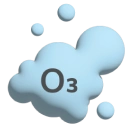
Ozone is present in nature at sky level. It helps by absorbing the harmful UV rays. But Ozone at ground level is harmful. Because it can highly impact the lungs of the human. With it, O3 is released from various sources. Some photocopier machines, some air purifiers. With it, other old home appliances can release O3 into the atmosphere.
SO2:

Sulfur Dioxide is a colourless, lethal gas. It is released from various sources in the indoor space. High SO2 concentration also causes acid rain. Its exposure can lead to various health problems such as eye, and throat irritation to respiratory tract infections.
Formaldehyde:
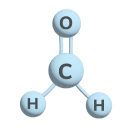
Formaldehyde is a highly toxic and flammable gas at room temperature. It is released from various sources. As the incense burning, furniture, freshly painted walls, etc. These cause extreme health issues that can irritate or lead to cancer.
Organizations for IAQ Standards and Guidelines management:
Many agencies and organizations are established to ensure better air quality. For this, they set numerous strict standards and guidelines. These play a crucial role in managing indoor air quality. Let us know how each organization works to manage indoor air quality:
WELL Building Standard (WELL):

WELL is a healthy building certification. They ensure various requirements for a better environment in buildings. It also includes indoor air quality. Hence, they check the smoke-free environment, ventilation designs and other points in buildings.
EPA (Environmental Protection Agency):

The EPA is an agency in the US (United States) also known as a federal agency. It is responsible for human health and environmental protection. Thus, they provide many guidelines and resources for indoor air quality. These guidelines include pollutants, ventilation, and testing for air quality.
ASHRAE (American Society of Heating, Refrigerating and Air-Conditioning Engineers):

ASHRAE is an organization in America that is professional. For indoor air quality, they set heating, ventilation, and air conditioning systems standards. The proper ventilation and air filtration in buildings are maintained with their guidelines.
LEED (Leadership in Energy and Environmental Design):

LEED is a program for buildings that makes them the best for a healthy indoor environment. It is a green building certification program to promote sustainable building practices. They provide certificates to buildings that focus the measuring indoor air quality for improving.
BREEAM (Building Research Establishment Environmental Assessment Method):

BREEAM is also a green building certification program. It is based in the United Kingdom. It focuses on the criteria for indoor air quality. As it includes the ventilation rates and pollutant levels.
NIOSH (National Institute for Occupational Safety and Health):

NIOSH is a US-based federal agency for safety and health. It focuses on occupational safety and health. Thus, they set guidelines to save workers from pollutant exposure at workplaces. For this, they conduct various research and make recommendations.
OSHA (Occupational Safety and Health Administration):

OSHA is a federal agency in the United States. It sets standards for workplace safety that include indoor air quality. They ensure that a safe working environment is provided to employees by employers. For this, maintaining good indoor air quality is necessary.
WHO (World Health Organization):

The WHO is a specialized and global organization. They set guidelines and standards for public health. With it, the organization has the leading role in achieving global health. Thus, they provide guidelines and information on indoor air quality and its effects. Besides, they also provide recommendations for better IAQ in indoor spaces.
ACGIH (American Conference of Governmental Industrial Hygienists):

ACGIH is an organization that focuses on setting guidelines for industrial hygiene practice. Hence, it includes indoor air quality monitoring and control. Their guidelines and recommendations include ensuring workers’ safety from harmful pollutants exposures at the workplace.
Canadian Standards for IAQ
The standards and guidelines for indoor air quality in Canada are set by some organizations. As Canadian Centre for Occupational Health and Safety (CCOHS) and Health Canada are the known associations. Their standards ensure and help in the protection from indoor air pollutants.
The indoor Air pollution limits as per different organizations are acceptable:
Various organizations have defined acceptable limits for indoor air pollutants, ensuring occupant safety and well-being. Know about the parameters ranges as per IAQ Standards and Guidelines:
| Pollutant | WHO | ASHRAE | EPA | LEED | ACGIH | Canadian Standards | OSHA | NIOSH | WELL |
| Carbon Dioxide (CO2) | – | 1000 ppm (8hr) | – | – | – | – | 5000 ppm, 30000 ppm (15min ceiling) | – | – |
| Carbon Monoxide (CO) | 7 mg/m³ (8hr) | 9 ppm (8hr) | 9 ppm (8hr), 35 ppm (1hr) | – | 25 ppm (8hr) | – | 35 ppm (8hr), 50 ppm (Ceiling) | 25 ppm (8hr), 50 ppm (Ceiling) | – |
| Formaldehyde | 100 µg/m³ | – | 0.75 ppm (8hr), 2 ppm (15min ceiling) | – | 0.3 ppm (Ceiling) | – | 0.75 ppm (8hr) | 0.016 ppm (STEL), 0.1 ppm (Ceiling) | – |
| Nitrogen Dioxide (NO2) | 40 µg/m³ (annual) | – | – | – | 3 ppm (Ceiling), 5 ppm (STEL) | – | 1 ppm (STEL) | – | – |
| Ozone (O3) | 100 µg/m³ (8hr) | – | 0.070 ppm (8hr) | – | – | – | 0.1 ppm (Ceiling) | – | – |
| PM2.5 | 10 µg/m³ (annual), 25 µg/m³ (24hr) | – | 12 µg/m³ (annual), 35 µg/m³ (24hr) | – | – | – | – | – | – |
| PM10 | 20 µg/m³ (annual) | – | 150 µg/m³ (24hr) | – | – | – | – | – | – |
| Sulfur Dioxide (SO2) | 20 µg/m³ (daily) | – | – | – | 2 ppm (Ceiling), 5 ppm (STEL) | – | 2 ppm (Ceiling), 5 ppm (STEL) | – | – |
| Radon | – | – | – | – | – | 200 Bq/m³ (Canada) | – | – | – |
STEL: short-term exposure limit
PPM: Parts Per Million
µg/m³: micrograms (one-millionth of a gram) per cubic meter air
mg/m³: Milligram per cubic meter
Bq/m³: becquerels per cubic meter
By adhering to these standards and guidelines, anyone can effectively manage IAQ, fostering healthier indoor environments for all.

